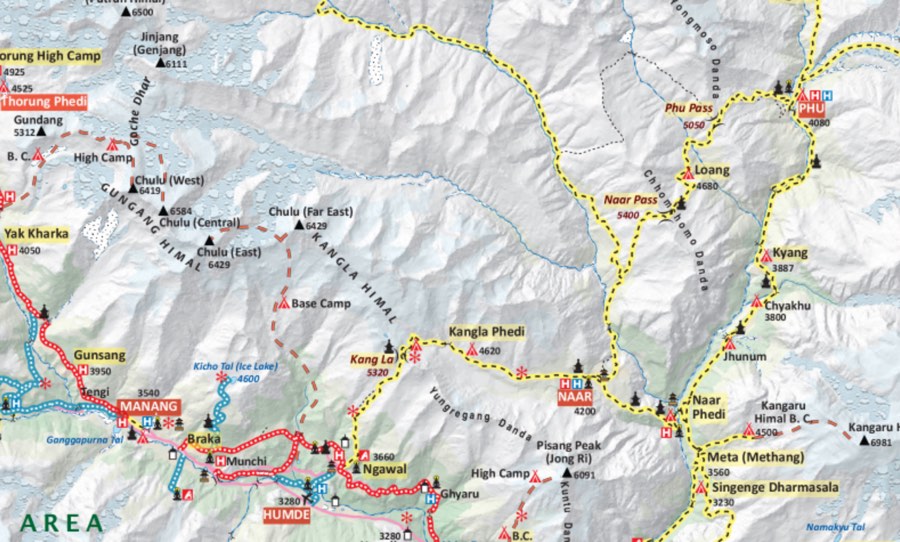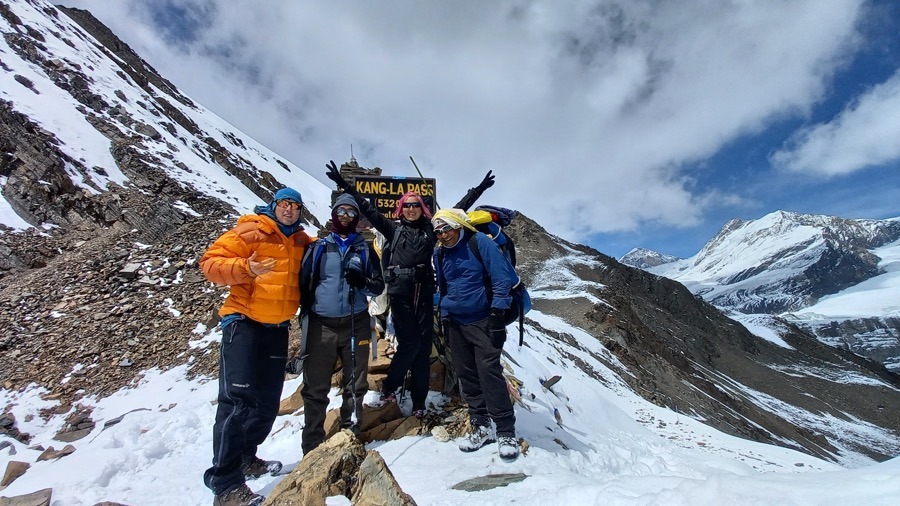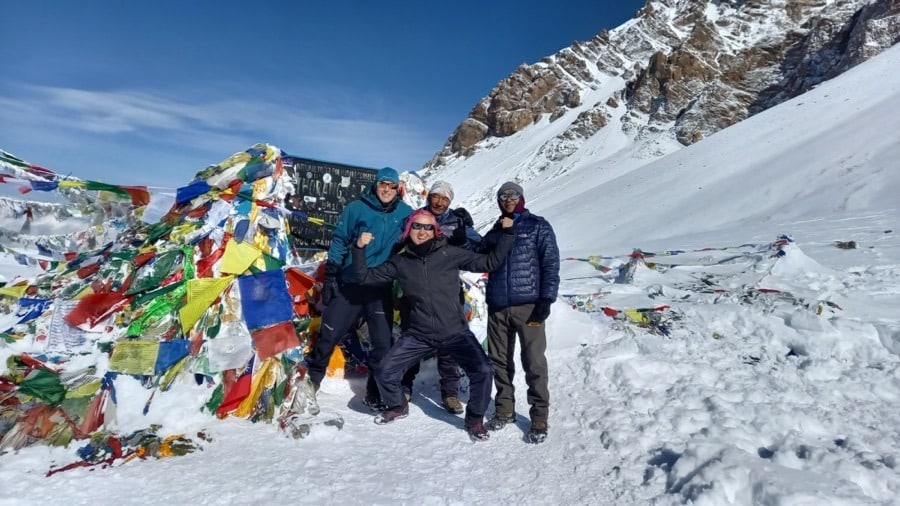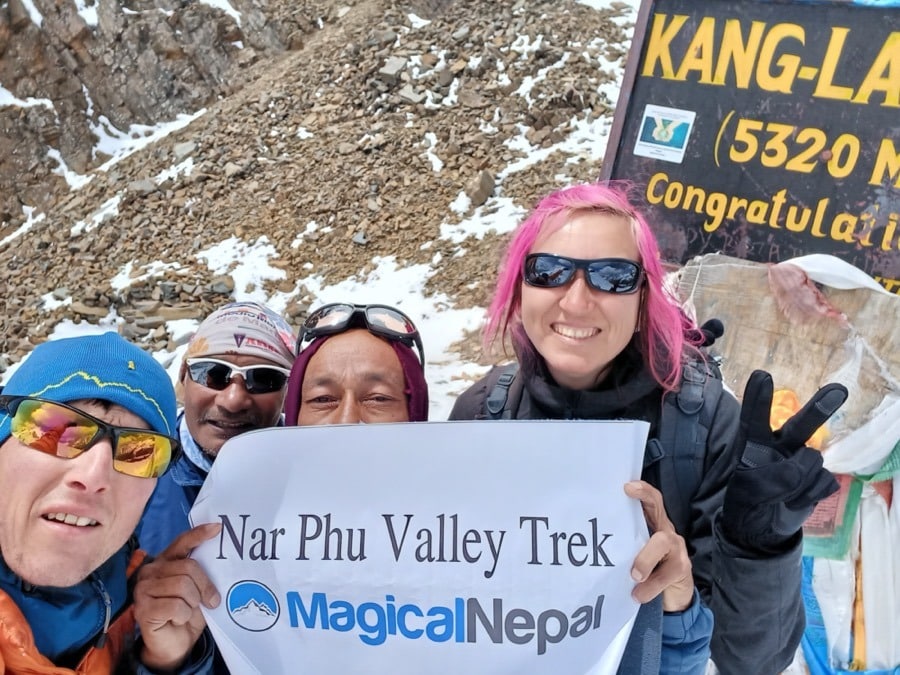Nar Phu Valley Trek
- Satisfied Client
- Personalised Guide
- Instant Response
Get Instant Response:
+977-9851329446 (Whatsapp)
| Starts at: Jagat | Ends at: Pokhara |
| Trek Region: Annapurna | Transport: Public Bus |
| Duration: 16 Days | Trip Grade: Challenging |
| Max Altitude: 5,416 m / 17,769 ft (Thorong La Pass) | Accommodation: Teahouse |
Nar Phu Valley Trek Highlights
- Explore the Tibetan-influenced lifestyles and everyday activities of the typical denizens
- Amazing walk past the interesting rock structures, land formations
- Be in the heart of the Annapurna mountains, where you can see Annapurna, Manaslu, and Dhaulagiri, among many more high mountains.
- The diverse topography of the region
- Accompanied by the chain of Himalayas, including Manaslu, Dhaulagiri, and Annapurna
- Walk through the popular challenging pass of the region Thorong La Pass (5,416 meters)
- Spiritual satisfaction on passing through different chortens, gompa, monasteries, and flags
The Nar Phu Valley trek only opened in 2003 and still remains a relatively little-trekked area. In fact, this hidden valley requires a special permit to enter.
Situated just off the Annapurna Circuit route, the trail to Nar Phu explores remote villages, Tibetan-like peoples, forests, narrow canyons, Buddhist Gompa, and majestic mountains.
A bridge over the Marshyangdi River brings the trail to the steep portals of the Nar Phu Valley, which is easy to miss. Once through the narrow, forested ‘entrance,’ a whole other world awaits.
Although the days are not as long as on some other treks, 5-6 hours is challenging: a good fitness level is a must, and prior trekking experience is recommended. Among the stunning rock formations and glaciers, the mountains that are seen along this route include Manaslu (8,163m), Dhaulagiri (8,167m), and Annapurna I (8,091m).
The route to Nar Phu Valley goes through Manang and continues over the Thorong La Pass to rejoin the Annapurna Circuit trail at the Hindu pilgrimage town of Muktinath.
From Jomsom in the Mustang area, and a few hour’s walk from Muktinath, it is possible to either fly to Pokhara or continue to trek down the Kali Gandaki River, past the interesting and unique village of Marpha and take in what is considered the viewpoint of the Annapurna’s, Poon Hill.
Passing through the Nar Phu Valley, it is possible to take in the culture of the people living there. In this remote area, the farmers live as they have always done, growing potatoes, barley, buckwheat, and vegetables and raising yaks and sheep.
For those who want to be in the Annapurna and witness the high, white, glistening mountains of this area but who want to be off the beaten track, the Nar Phu Valley trek might just be what they are looking for.
Permits Required for the Nar Phu Valley Trek
Every foreign trekker in Nepal must take a guide on their trek, as per the new rules of 1 April 2023. The only exception to this is the Everest Region. In the Annapurna Region, you must trek with a registered Nepal trekking company and pay the necessary government permits fees. As the Nar Phu Trek takes place in a restricted area, you are also required to pay a restricted area fee, which varies in price depending on the season. In addition, there must be at least two trekkers (plus the guide) in all restricted areas for entry.
Annapurna Conservation Area Permit: Nrs3,000 per person
Restricted Area Permit: September to November USD100 per person per week
December to August USD 75 per person per week
For this trek, you will need two weeks of restricted area permit.
We at Magical Nepal will obtain these permits on behalf of our guests.
A Typical Day on the Nar Phu Trek
The days on this trek vary in terms of time and scenery. On the whole, expect to hike for around 6 hours a day, but there are two days where you spend 8-plus hours on the trail. That is when you climb up and over the Ngawal Via Kang La Pass (3,600 m / 12,171 ft) and the Thorong La Pass at over 5,400m/ 17,700 ft. These days are particularly challenging, and trekkers should be prepared for a hard, long climb and, if the weather closes in, perhaps wait it out before crossing into the previous night’s lodge.
Lodges on this trek, known as teahouses, are quite basic. We suggest you bring your own sleeping bag and consider a sleeping mat. There may be some nights you are required to share a room with other trekkers. And bathrooms are shared spaces also.
After crossing the Thorong La, accommodation improves, and there are some rather nice lodges throughout Mustang. Food can be quite basic on this trek, with little or no meat available (we do not recommend eating meat on remote or high treks anyway). Vegetables will be freshly prepared, and the tea is always hot!
Being a remote area, we suggest you bring your own supply of energy or chocolate bars, as there are very few shops until you cross over into Mustang.
The days start early after breakfast, taken in the same lodge we sleep in. Dinner is taken in the next overnight location. Lunch is taken on the trail and will most likely be noodles, rice, and curry.
On the long trekking days, we do not go faster than our bodies, and the altitude will allow
Two acclimatization days are built into the itinerary to prepare trekkers for the higher altitude going over the passes.
Despite being a challenging and often demanding trek, the rewards are stunning scenery, an insight into a different side of Nepal, both culturally and scenically, and a great sense of achievement.
Important Notes for the Nar Phu Valley Trek
- This is a two-week trek with some very long days. Therefore, it would be sensible to have a trekking experience before embarking on this. (We have many other treks in this and other regions for those less experienced.)
- A good fitness level is required, again, because of the long days and sometimes rough terrain.
- Be prepared mentally and physically for the challenging Thorong La Pass crossing.
- If you would like to continue your trek after Jomson (rather than flying back to Pokhara), please ask us about this option.
- Accommodation at some of the locations is very basic. Please be prepared for shared toilets and sleeping rooms in some lodges.
- Bringing your sleeping bag is recommended.
- Porters are not included in the cost of this trek, but we can offer you the use of a porter at an additional charge. Please talk to us about this.
- Meals are included on the trek, but extra charges are payable to the teahouse/ lodge for things like hot showers and charging your phone/ camera.
- In some locations, it might be hard to charge your phone, so carry a power bank with you.
- Water is essential on a trek! We recommend 3 liters a day. It is a good idea to bring a sterilization straw or drops with you. Most lodges will provide you with boiled drinking water at a cost. Please do not drink the stream water. It might look delicious and cold, but you don’t know what is lying (literary) upstream!
- Meals are not provided in Pokhara, but we can recommend some great restaurants.
- Please ensure your insurance covers trekking up to an altitude of 5,000m.
- Please do not haggle with the lodge owners over prices. It is often a long and expensive process to bring goods into remote areas.
- One night’s accommodation in Pokhara is included in the cost of the trek. If you wish to stay longer in this beautiful lakeside town, please talk with us.
Best Season for the Nar Phu Valley Trek
As with most trekking areas, the best times for this trek are spring (March to early June) and autumn (September to the end of November). The skies will be clear, and the mountain views spectacular.
Having said that, this trek is also doable in the monsoon (late June to early September) season as it lies in the rain shadow. Expect rain in Kathmandu and Pokhara, and the lower villages, however. But in the valley itself, it will be dry and beautiful, and it is a great option for those with only free time during these summer/ monsoon months.
Nar Phu Valley Trek Packing List
The recommended packing list for the Nar Phu Valley is the same as any for trekking in Nepal. The only extra things you may need are crampons (in case of snow and ice) and a good four-seasons sleeping bag and mat. These are also desirable on other treks, but where the lodges are very basic, this becomes an important item on your list!
- Trekking boots – worn well before you arrive in Nepal
- Crampons (can be hired in Kathmandu)
- Down jacket
- Fleece jacket
- Gloves
- Warm hat and sun hat
- Sunglasses
- Sunscreen (the sun is stronger at altitude)
- Thermal vest and pants
- Trekking pants of the quick dry variety
- Quick-drying trekking shirt
- T-shirts for those warmer days
- Socks
- Personal toiletries (limited supply – no one showers daily!)
- Purifying straws and drops
- Personal medicines (enough for extra days in case of delays)
- Small first aid kit
Nar Phu Valley Trek Outline Itinerary
Day 1: Kathmandu to Jagat (Drive)
Jagat- 1290 m / ft – 10 hrs
Day 2: Jagat to Dharapani
Dharapani – 1830 m / 6003 ft – 7 hrs
Day 3: Dharapani to Koto
Koto – 2610 m / 8891 ft – 6 hrs
Day 4: Koto to Meta
Meta – 3560 m / 10826 ft – 7 hrs
Day 5: Meta to Phu
Phu – 4250 m / 11614 ft – 7 hrs
Day 6: Acclimatization Day
Phu – 4250 m / 11614 ft – 2 hrs
Day 7: Phu to Nar
Nar – 4110 m / 13484 ft – 6 hrs
Day 8: Acclimatization Day
Nar – 4110 m / 15091 ft – 3 hrs
Day 9: Nar to Ngawal Via Kang La Pass
Ngawal – 3600 m / 12171 ft – 9 hrs
Day 10: Ngawal to Manang
Manang – 3540 m / 8759 ft – 4 hrs
Day 11: Manang to Yak Kharka
Yak Kharka – 4110 m / 8300 ft – 3 hrs
Day 12: Yak Kharka to Thorong Phedi
Thorong Phedi – 4600 m / 3937 ft – 4 hrs
Day 13: Thorong Phedi to Muktinath via Thorong La Pass
Muktinath – 3710 m / 2723 ft – 9 hrs
Day 14: Muktinath to Jomsom
Jomsom – 2760 m / 2723 ft – 6 hrs
Day 15: Jomsom to Pokhara (Flight)
Pokhara – 830 m / ft – 20 min
Day 16: Pokhara to Kathmandu (Drive)
Kathmandu – 1300 m / 4265 ft – 8 hrs
Not satisfied with this Itinerary?
Are you interested on planning custom trip? It only takes 2 minutes.
Day 1: Kathmandu to Jagat (Drive) Jagat 1,290 m / ft – 10 hrs
Set off from Kathmandu in the early morning in to reach Jagat in the early evening. The road out of the Kathmandu Valley and onto the lower-lying lands follows the Trisuli River, where you may see people enjoying white water rafting. There are plenty of good coffee and lunch stops on the way. The road turns towards Pokhara, and we follow this good road until we turn off at Besisahar and enter Manang, with its more winding roads.
Overnight in Jagat
Day 2: Jagat to Dharapani Dharapani 1,830 m / 6,003 ft – 7 hrs
Today the trek begins! After breakfast, we set off out of the village of Jagat, heading towards our overnight stop at Dharapani. It is a hard first day, with plenty of steps to climb up and rough trails to follow. If you don’t fancy the idea of stone steps, ask your guide about an alternative route. Which there is. But the scenery of waterfalls, rivers, suspension bridges, terraced fields, and many goat herds makes up for it. Somewhat. But be assured; your tired legs will get used to the long hikes in the next few days. Stopping for lunch on route, we may sample Tibetan bread for the first time. Finally, we reach the teahouse (trekking lodge) at Dharapani, where we stay overnight.
Day 3: Dharapani to Koto Koto 2,610 m / 8,891 ft – 6 hrs
After breakfast, perhaps banana porridge, we trek through pine forests with tantalizing glimpses of Annapurna II until we reach Koto, where we overnight.
Day 4: Koto to Meta 3,560 m / 10,826 ft – 7 hrs
Today we enter the restricted area, passing a check post to do so. The trail takes us through pine forests, along the Soti Khola (river), and over rocky terrain. We can see caves and canyons on the way. We stop for lunch, most likely at Dharmasala village, before reaching Meta, where we stop for the night. Views of Annapurna II and Lamjung Himal fill the skyline.
Day 5: Meta to Phu Meta 4,250 m / 11,614 ft – 7 hrs
A wonderful day of cultural surprises. The trail takes us past beautiful Buddhist chortens (cairns/ shrines) with views of spectacular gorges, canyons, and ruins of Tibetan-style forts. Crossing a suspension bridge, we reach Phu, from where we can visit Tashi Lhakhang monastery.
Day 6: Acclimatization Day Phu 4,250 m / 11,614 ft – 2 hrs
We spend an extra day in Phu to acclimatize to the altitude before we trek higher and over the Kang La Pass in the days to come. Acclimatization is best done by keeping active, so we head off for a hike to Himlung Himal Base Camp and a glacier valley. Alternatively, there is plenty to see around the village of Phu itself with its yaks and yak herders. We stay overnight at Phu again.
Day 7: Phu to Nar Nar 4,110 m / 13,484 ft – 6 hrs
Today we retrace our steps a little to reach Nar. Before that, we cross a bridge over an amazing 80m deep narrow canyon. Tonight we attend evening prayers with the nuns who live there. We will also share dinner prepared by the nuns and experience the day-to-day life of the monastery. Please feel free to donate at the monastery and light some oil lamps for your loved ones.
Day 8: Acclimatization Day Nar 4,110 m / 15,091 ft – 3 hrs
Today we take an acclimatization day in Nar, a farming village in its bowl-like valley. With its name meaning ‘place of blue sheep,’ we notice that the people speak a Sino-Tibetan language, different from the rest of Manang.
Day 9: Nar to Ngawal Via Kang La Pass ( 5,240m) Ngawal 3,600 m / 12,171 ft – 9 hrs
A challenging day but with views that make up for the ache in our legs! From the top of the Kang La Pass, we see the stunning mountains of Annapurna II, Gangapurna, and Tilicho Peak. Finally, we reach Ngawal, and here we can find Wi-Fi to relay some of our stories back home.
Day 10: Ngawal to Manang Manang 3,540 m / 8,759 ft – 4 hrs
Today our bodies appreciate the shorter trekking time and less steep trails. Our spirits also enjoy the rich Buddhist heritage we will see today. Leaving Ngawal, we drop down, passing Sher Gompa and surrounding settlements and even Milaperpa’s cave. Milaperpa is a major figure in the Kagyu school of Tibetan Buddhism and was a dedicated yogi, spiritual leader, and teacher. Born around 1052, he travelled to what is now Nepal, and various sites are dedicated to his memory. We also pass Braga Gompa, which is around 900 years old, and the Gompa of Godzo before crossing the Ghatte Khola and reaching the town of Manang, where we overnight.
Day 11: Manang to Yak Kharka Yak Kharka 4,110 m / 8,300 ft – 3 hrs
Another short day in this stunning Tibetan-like landscape. There are steep sections of the trail, but some shops in Manang are exciting. And some artifacts are being sold on the trail. But remember, the Thorong La Pass is coming, so don’t buy too much!
Day 12: Yak Kharka to Thorong Phedi Thorong Phedi 4,600 m / 3,937 ft – 4 hrs
The stark landscape continues, and there is a landslide area to pass today. Pay close attention to your guide’s advice. Since it is a relatively short trek, you should spend the afternoon hiking to High Camp in preparation for Tomorrow’s high-altitude pass crossing. Alternatively, enjoy the surrounding mountains, Annapurna II, III, IV, Pisang Peak, Chulu, and Tilcho, while enjoying a cinnamon roll. Yes, last time we were there, there was a bakery at one of the Which we highly recommend is make complete preparation for the morning. We will be setting off early to cross the Thorong La Pass so please pack your belongings the night before and get a good night’s rest.
Day 13: Thorong Phedi to Muktinath via Thorong La Pass Muktinath 3,710 m / 2,723 ft – 9 hrs
After an early breakfast, we head out to conquer the pass! It may be foggy when we set off, but the weather will improve as the sun rises. The pass is over 5,400m high and takes a long 9 hours to cover its 15km path. Extremely hard going, it may be possible to hire mules for anyone who thinks the challenge is too much. Please note this is not a certainty.
But this is one of the most exciting days of the trek. The Hindu pilgrimage town of Muktinath is a welcome sight at the end of this long day. With a comfortable lodge and a good dinner, you can relish what you have achieved today.
Day 14: Muktinath to Jomsom Jomsom 2,760 m / 2,723 ft – 6 hrs
After breakfast, you have time to visit the temple of Muktinath with its 108 water spouts. No need to bathe in them all unless you are Hindu or particularly enjoy cold showers! Then we trek down to the airport town of Jomson. Suppose you wish to spend more time in Muktinath or explore the interesting village of Kagbeni on the route. In that case, it is possible to take a jeep down from Muktinath to Jomson or Kagbeni (then it’s around a 2-3 hour walk from Kagbeni to Jomson). In Jomsom, we find many shops, bars, and hotels to relax in.
Day 15: Jomsom to Pokhara (Flight) 20 min
This itinerary includes the early morning flight to Pokhara, which gives you a whole day in this vibrant lakeside town. An alternative would be to continue your trek for another 3 or 4 days down through Mustang and perhaps up to the famous Poon Hill. Please discuss this with us when booking your trek.
Day 16: Pokhara to Kathmandu (Drive) Kathmandu 1,300 m / 4,265 ft – 8 hrs
Today we head back to Kathmandu by comfortable tourist bus.
Includes
- 15 nights accommodation in mountain teahouses
- 1 nights accommodation in Pokhara Kuti Resort or similar
- Guide for 16 days
- Kathmandu Khudi local bus
- Jomsom Pokhara flight
- Pokhara Kathmandu tourist bus
- Annapurna conservation area permit
- Restricted area permit
- Trekkers information management system card
- 16 x breakfast, 16 x lunch and 15 x dinner while on the trek
- One Porter for 16 days USD 320
- Lunch and dinner in Pokhara
Nar Phu Valley Trek Map

Related Trip in Annapurna Region
Annapurna Base Camp Trek | Ghorepani Poon Hill Trek | Dhaulagiri Circuit Trek | Upper Mustang Trek | Tiji Festival Trek | Mardi Himal Base Camp Trek | Nar Phu Teri La Upper Mustang Trek | Khopra Ridge Trek | Tilicho Lake And Annapurna Circuit Trek | Annapurna Base Camp Helicopter Tour | Saribung Peak With Upper Mustang | Himlung Expedition With Nar Phu Valley



